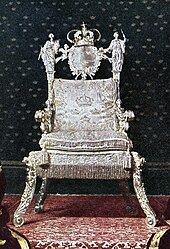
Back Linie následnictví švédského trůnu Czech Den svenske tronfølge Danish Thronfolge (Schweden) German Sucesión al trono de Suecia Spanish Rootsi troonipärimisjärjekord Estonian Ordre de succession au trône de Suède French סדר הירושה לכתר השוודי HE Pewaris takhta Kerajaan Swedia ID Linea di successione al trono di Svezia Italian スウェーデン王位継承順位 Japanese
You can help expand this article with text translated from the corresponding article in Swedish. (March 2024) Click [show] for important translation instructions.
|
| Part of a series on |
| Orders of succession |
|---|
| Monarchies |

The line of succession to the Swedish throne is determined by the Act of Succession (Swedish: Successionsordningen), originally approved jointly by the Riksdag of the Estates assembled in Örebro and King Charles XIII in 1810.[1][2]
In 1979, the Riksdag introduced absolute primogeniture, meaning that the eldest child of the monarch, regardless of gender, is first in the line of succession. The change entered into force on 1 January 1980,[3][4] making Sweden the first country to adopt absolute primogeniture.[5] The Swedish crown had previously (since 1810) descended according to agnatic primogeniture, meaning that only males could inherit it.[6] Though the change took effect in 1980, its application was backdated so that Crown Princess Victoria, who was born in 1977, became the first in line of succession, replacing her brother, Prince Carl Philip, who was born in 1979.
- ^ "Act of Succession" (PDF). Riksdag. Retrieved 2019-07-30.
- ^ "Successionsordning (1810:0926)" (in Swedish). Riksdag. Retrieved 2019-07-30.
- ^ Cite error: The named reference
guswas invoked but never defined (see the help page). - ^ Cite error: The named reference
vickywas invoked but never defined (see the help page). - ^ "Duties of the Monarch". www.kungahuset.se. Swedish Royal Court. Retrieved 22 December 2013.
By this principle, which Sweden is the first country to have introduced, the throne passes to the eldest child, whether male or female.
- ^ Cite error: The named reference
joakimwas invoked but never defined (see the help page).
© MMXXIII Rich X Search. We shall prevail. All rights reserved. Rich X Search